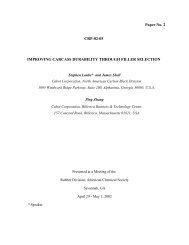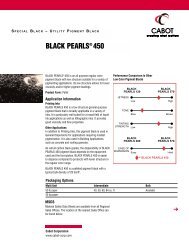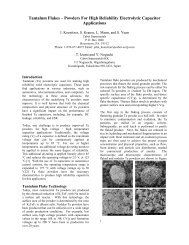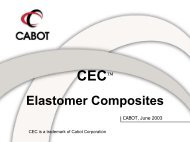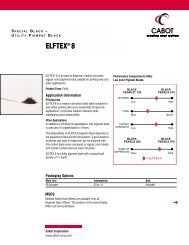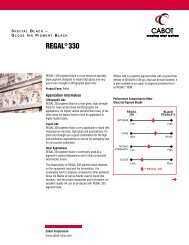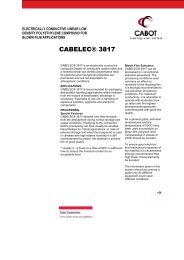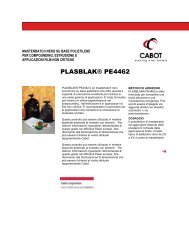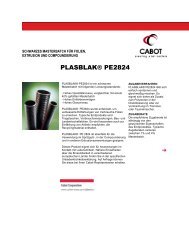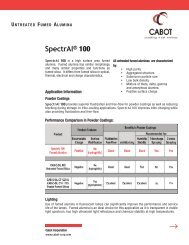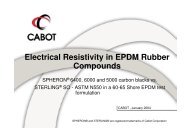Effect of Functionalization of Carbon Black on Rubber Properties
Effect of Functionalization of Carbon Black on Rubber Properties
Effect of Functionalization of Carbon Black on Rubber Properties
Create successful ePaper yourself
Turn your PDF publications into a flip-book with our unique Google optimized e-Paper software.
Introducti<strong>on</strong><br />
The tire industry requires c<strong>on</strong>tinuous development in the areas <str<strong>on</strong>g>of</str<strong>on</strong>g><br />
• Increased durability;<br />
• Better fuel ec<strong>on</strong>omy; and<br />
• Improved safety.<br />
2<br />
CRX4XXX-012-FTF’01-Simp.doc<br />
These requirements can <strong>on</strong>ly be met by improvement <str<strong>on</strong>g>of</str<strong>on</strong>g> wear resistance, rolling<br />
resistance and skid resistance, especially in wet c<strong>on</strong>diti<strong>on</strong>s. From the compounding point<br />
<str<strong>on</strong>g>of</str<strong>on</strong>g> view, it has been recognized that the filler and polymer play an equally important role<br />
in governing the compound properties, thus tire performance. In fact, the term filler is<br />
misleading as it implies a material that increases the volume and reduces the compound<br />
cost. Additi<strong>on</strong>ally, the filler cannot <strong>on</strong>ly be c<strong>on</strong>sidered to be what is comm<strong>on</strong>ly referred<br />
to as a “reinforcing agent” in the sense <str<strong>on</strong>g>of</str<strong>on</strong>g> a material that increases modulus and improves<br />
the tensile strength <str<strong>on</strong>g>of</str<strong>on</strong>g> the compound. What is comm<strong>on</strong>ly referred to as “filler” is actually<br />
a functi<strong>on</strong>al material or comp<strong>on</strong>ent which has a significant effect <strong>on</strong> tire performances.<br />
It has been well established that the wear resistance <str<strong>on</strong>g>of</str<strong>on</strong>g> filled rubber is essentially<br />
determined by the polymer-filler interacti<strong>on</strong>. For fillers having similar morphologies, the<br />
increase in polymer-filler interacti<strong>on</strong>, either through enhancement <str<strong>on</strong>g>of</str<strong>on</strong>g> physical adsorpti<strong>on</strong><br />
<str<strong>on</strong>g>of</str<strong>on</strong>g> polymer chains <strong>on</strong> the filler surface or via creati<strong>on</strong> <str<strong>on</strong>g>of</str<strong>on</strong>g> chemical linkages between filler<br />
and polymer, is crucial to the enhancement <str<strong>on</strong>g>of</str<strong>on</strong>g> wear resistance.<br />
It has also been established that there is a good correlati<strong>on</strong> between the rolling resistance<br />
<str<strong>on</strong>g>of</str<strong>on</strong>g> tires and the hysteresis <str<strong>on</strong>g>of</str<strong>on</strong>g> the tread compound, characterized by the loss factor, tan δ,<br />
at high temperature. The hysteresis is in turn determined by the filler networking which is<br />
governed by polymer-filler, and especially filler-filler interacti<strong>on</strong>s. 1 The str<strong>on</strong>ger the<br />
filler-filler interacti<strong>on</strong>, the more developed is the filler network, hence the higher the<br />
rolling resistance <str<strong>on</strong>g>of</str<strong>on</strong>g> tires.<br />
In the last few years, in resp<strong>on</strong>se to ever more demanding requirements from the tire<br />
industry, a great effort has been made by Cabot Corporati<strong>on</strong> to develop functi<strong>on</strong>alized



